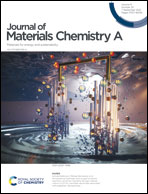All-in-one polarized Cd/CdS/halloysite ferroelectric hybrid for exceptional photocatalytic hydrogen evolution†
Abstract
Sulfide nanomaterials are a type of highly promising photocatalysts for water splitting into H2 due to their suitable band gap and energy potentials but have the disadvantages of agglomeration and rapid charge recombination. Herein, an all-in-one hybrid photocatalyst Cd/CdS/halloysite nanotubes (P-Cd/CdS/HNTs) with strong ferroelectric polarization for exceptional H2 evolution is developed by a three-step process, namely electrostatic assembly, combined photo and chemical reduction, and corona poling. HNTs serve as excellent substrates for well-dispersed CdS nanospheres with more exposed catalytic sites, and the in situ formed metallic Cd from CdS enhances photoabsorption and surface charge separation. Notably, corona poling results in largely strengthened intrinsic spontaneous polarization, which provides a stronger internal electric field for the separation and transfer of photoexcited charges in bulk CdS. The above-mentioned advantages collectively allow P-Cd/CdS/HNTs an enormously enhanced photocatalytic H2 evolution with a rate of 32.11 mmol g−1 h−1, which is approximately 33-fold over that of pristine CdS, and appreciable apparent quantum efficiency of 45.13% at λ = 420 nm, being one of the best CdS-based photocatalysts. This work establishes that developing strongly polar sulfide ferroelectrics is a promising direction for solar-energy catalytic conversion and provides a new reference for fabricating efficient all-in-one hybrid photocatalysts.



 Please wait while we load your content...
Please wait while we load your content...